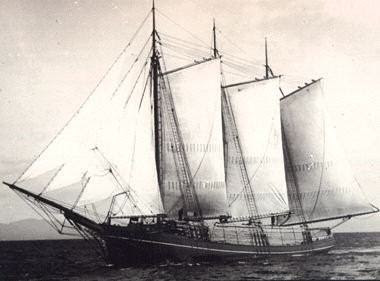 |
| Schooner WAWONA Photo by Capt. H. H. Morrison Submitted by author. |
"February 26 2011, was a special morning for Roy and Annie because we were out of bed by 4:00 AM to meet Les Bolton, Executive Director of the Grays Harbor Historical Seaport Authority, and a crew of other volunteers in Montesano, WA. By 6:00 AM we were off to rescue WAWONA's bones off Sandpoint Way in Seattle.
The weather was not especially cooperative, with a temperature of 14.8℉, and a recent snowfall lingering in the shadows, but the roads seemed clear so we were off on our adventure. The Black Hills section of Hwy 8 was coated with compact snow and ice near McLeary, but we slowed down with a 2-axle equipment trailer behind, and carried on without a slip.
WAWONA's bones were the salvaged portions of the stately old lumber schooner, WAWONA, that was built in Eureka, CA, in 1897. She had served well as a lumber schooner, moving redwood and fir lumber to ports up and down the west coast until 1914, when she was converted to a cod fisher. One of her captains was Ralph E. Peasley who became famous as the model for Capt. Matt Peasley, the 'fictional' hero in Peter B. Kyne's adventure novel Cappy Ricks, or the Subjugation of Matt Peasley, published in 1916.
In 1914 WAWONA was purchased by the Robinson Fisheries Company in Anacortes, WA, loaded with tons of salt for preserving cod, and with provisions to last 38 fishermen for six months, sailed to the Bering Sea. At the fishing grounds 24 dories would fan out in all directions, each with a fisherman and his hand lines. They fished all day long to fill each dory with cod fish before returning to the mother ship at nightfall. When the fog closed in, the fisherman and his dory were isolated and alone except for the periodic sound of the WAWONA's horn which provided the location of home.
Those days are long past and today WAWONA would be making one last trip. After riding at anchor in Lake Union for many years, she had finally been scrapped and her knees, rigging screws, blocks, bowsprit, capstan, keel, and other bones were waiting for us in the corner of a parking lot near the NOAA facility on Sandpoint Way. The day was mostly clear but a biting wind blew in off the lake as we went about our business. With the help of a cranky old fork-lift the trailers and pickups were loaded with pallets and boxes and lashed down for their ignominious last voyage through Seattle rush hour traffic to the Grays Harbor Historical Seaport in Aberdeen, WA."
Written by Roy PearmainFor Saltwater People Historical Society
June 2011.
 |
| Anchor winch from the Schooner WAWONA, c. 10,000 pounds. |
 |
| Schooner WAWONA keel section, February 2011 |
 |
| Salvaged bowsprit of the Schooner WAWONA Southbound Seattle to Aberdeen, February 2011. |
 |
| Salvaged Blocks from the WAWONA. |
 |
| WAWONA's rigging gets loaded, too. All salvage photos courtesy of Roy Pearmain, 2011. |








